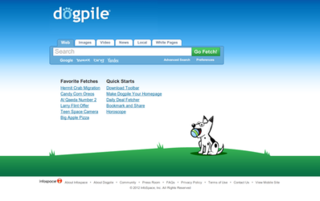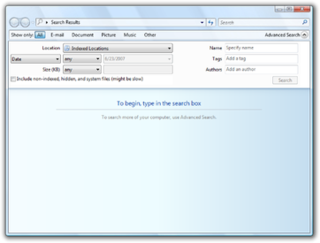
Ogg is a free, open container format maintained by the Xiph.Org Foundation. The authors of the Ogg format state that it is unrestricted by software patents and is designed to provide for efficient streaming and manipulation of high-quality digital multimedia. Its name is derived from "ogging", jargon from the computer game Netrek.
A search engine is an information retrieval system designed to help find information stored on a computer system. The search results are usually presented in a list and are commonly called hits. Search engines help to minimize the time required to find information and the amount of information which must be consulted, akin to other techniques for managing information overload.
RealAudio, or also spelled as Real Audio is a proprietary audio format developed by RealNetworks and first released in April 1995. It uses a variety of audio codecs, ranging from low-bitrate formats that can be used over dialup modems, to high-fidelity formats for music. It can also be used as a streaming audio format, that is played at the same time as it is downloaded. In the past, many internet radio stations used RealAudio to stream their programming over the internet in real time. In recent years, however, the format has become less common and has given way to more popular audio formats. RealAudio was heavily used by the BBC websites until 2009, though it was discontinued due to its declining use. BBC World Service, the last of the BBC websites to use RealAudio, discontinued its use in March 2011.
MPEG-7 is a multimedia content description standard. It was standardized in ISO/IEC 15938. This description will be associated with the content itself, to allow fast and efficient searching for material that is of interest to the user. MPEG-7 is formally called Multimedia Content Description Interface. Thus, it is not a standard which deals with the actual encoding of moving pictures and audio, like MPEG-1, MPEG-2 and MPEG-4. It uses XML to store metadata, and can be attached to timecode in order to tag particular events, or synchronise lyrics to a song, for example.

Dogpile is a metasearch engine for information on the World Wide Web that fetches results from Google, Yahoo!, Yandex, Bing, and other popular search engines, including those from audio and video content providers such as Yahoo!.

Content-based image retrieval, also known as query by image content (QBIC) and content-based visual information retrieval (CBVIR), is the application of computer vision techniques to the image retrieval problem, that is, the problem of searching for digital images in large databases. Content-based image retrieval is opposed to traditional concept-based approaches.

High-Efficiency Advanced Audio Coding (HE-AAC) is an audio coding format for lossy data compression of digital audio defined as an MPEG-4 Audio profile in ISO/IEC 14496–3. It is an extension of Low Complexity AAC (AAC-LC) optimized for low-bitrate applications such as streaming audio. The usage profile HE-AAC v1 uses spectral band replication (SBR) to enhance the modified discrete cosine transform (MDCT) compression efficiency in the frequency domain. The usage profile HE-AAC v2 couples SBR with Parametric Stereo (PS) to further enhance the compression efficiency of stereo signals.
A container format or metafile is a file format that allows multiple data streams to be embedded into a single file, usually along with metadata for identifying and further detailing those streams. Notable examples of container formats include archive files and formats used for multimedia playback. Among the earliest cross-platform container formats were Distinguished Encoding Rules and the 1985 Interchange File Format.
Flash Video is a container file format used to deliver digital video content over the Internet using Adobe Flash Player version 6 and newer. Flash Video content may also be embedded within SWF files. There are two different Flash Video file formats: FLV and F4V. The audio and video data within FLV files are encoded in the same way as SWF files. The F4V file format is based on the ISO base media file format, starting with Flash Player 9 update 3. Both formats are supported in Adobe Flash Player and developed by Adobe Systems. FLV was originally developed by Macromedia. In the early 2000s, Flash Video was the de facto standard for web-based streaming video. Users include Hulu, VEVO, Yahoo! Video, metacafe, Reuters.com, and many other news providers.
A video search engine is a web-based search engine which crawls the web for video content. Some video search engines parse externally hosted content while others allow content to be uploaded and hosted on their own servers. Some engines also allow users to search by video format type and by length of the clip. The video search results are usually accompanied by a thumbnail view of the video.
Compared with previous versions of Microsoft Windows, there are numerous features new to Windows Vista, covering most aspects of the operating system, which include additional management features, new aspects of security and safety, new I/O technologies, new networking features, and new technical features. Windows Vista also removed some others.
Multimedia search enables information search using queries in multiple data types including text and other multimedia formats. Multimedia search can be implemented through multimodal search interfaces, i.e., interfaces that allow to submit search queries not only as textual requests, but also through other media. We can distinguish two methodologies in multimedia search:
SpeechBot was a web search engine for streaming media content developed at Compaq's research laboratories in Cambridge, MA and Australia. Compaq launched the website at Streaming Media West 1999 in San Jose, CA. The internet radio shows indexed by SpeechBot included The Motley Fool, Fresh Air, Talk of the Nation, The Dr. Laura Program, and Dreamland with Art Bell. By June 2003, the service had indexed over 17,000 hours of multimedia content. The website was taken offline in 2005, after HP closed their Cambridge research lab.

MPEG-4 Part 14 or MP4 is a digital multimedia container format most commonly used to store video and audio, but it can also be used to store other data such as subtitles and still images. Like most modern container formats, it allows streaming over the Internet. The only filename extension for MPEG-4 Part 14 files as defined by the specification is .mp4. MPEG-4 Part 14 is a standard specified as a part of MPEG-4.
AXMEDIS is a set of European Union digital content standards, initially created as a research project running from 2004 to 2008 partially supported by the European Commission under the Information Society Technologies programme of the Sixth Framework Programme (FP6). It stands for "Automating Production of Cross Media Content for Multi-channel Distribution". Now it is distributed as a framework, and is still being maintained and improved. A large part of the framework is under open source licensing. The AXMEDIS framework includes a set of tools, models, test cases, documents, etc. supporting the production and distribution of cross media content.
PolyCola, previously known as GahooYoogle, is a metasearch engine which was created by Arbel Hakopian.

Windows Search is a content index desktop search platform by Microsoft introduced in Windows Vista as a replacement for both the previous Indexing Service of Windows 2000 and the optional MSN Desktop Search for Windows XP and Windows Server 2003, designed to facilitate local and remote queries for files and non-file items in compatible applications including Windows Explorer. It was developed after the postponement of WinFS and introduced to Windows constituents originally touted as benefits of that platform.
A visual search engine is a search engine designed to search for information on the World Wide Web through the input of an image or a search engine with a visual display of the search results. Information may consist of web pages, locations, other images and other types of documents. This type of search engines is mostly used to search on the mobile Internet through an image of an unknown object. Examples are buildings in a foreign city. These search engines often use techniques for Content Based Image Retrieval.
Munax was a Swedish company that developed a Large Hyper-Parallel Execution (LHPE) search engine system Munax XE. Munax XE, is an all-content search engine and powered nationwide and worldwide public search engines with page, document, audio, video, images, software, and email search. Other customers included vertical search engines and mobile operators.
MetaCrawler is a search engine. It is a registered trademark of InfoSpace and was created by Erik Selberg.






